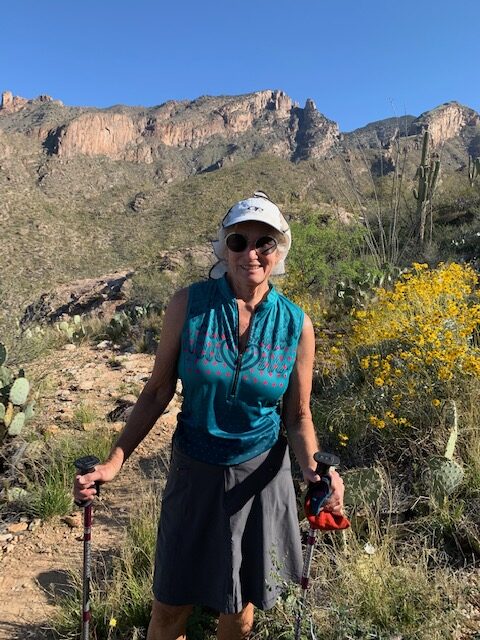
As I cocoon (shelter in place) in my casita, maintaining social distance and venturing out only for a daily dose of physical activity and infrequent gathering of food and supplies, I am still trying to wrap my head around the fact that at age 71 I am in the high-risk, elderly category of this C-19 pandemic. Healthy, normal weight, physically active, no chronic diseases and no RX medications – I am still high risk due to my age.
A paper published March 30, 2020 in Lancet Infectious Diseases, by researchers at the Imperial College of London announced the most comprehensive estimates of elevated risk of serious illness (symptoms severe enough to require hospitalization and respiratory support) and death in the elderly from Covid-19. Their data indicates the following mortality rates by age, with the sharpest divide happening at age 70.
Mortality rate Age
0.3% 40s
1.25% 50s
4.0% 60s
8.6% 70s
13.4% 80 plus
(Data collected from patients who died from COVID-19 in Hubei, mainland China, reported by national and provincial health commissions through Feb 8, 2020, and for cases outside mainland China, reported from government or ministry of health websites and media reports for 37 countries, as well as Hong Kong and Macau, until Feb 25, 2020.)
The data also indicated preexisting conditions dramatically raise the risk of dying from Covid-19 and that fragility and declining immunity may be contributors.
It is apparent that age, the number of co-morbidities (chronic diseases) and the strength of the individual’s immune system influence the severity of symptoms and risk of hospitalization and death from Covid-19.
Immunologists have identified some of the specific changes in the immune system associated with aging (immunosenescence). Basically, “our immune system has two sets of defenses against viruses and other pathogens: a first-line army of cells, called leukocytes, that attack invading microbes within minutes to hours, and a second-line force of precisely targeted antibodies and T cells that surge to the battle front as late as several days after”. With advancing age, and/or chronic disease conditions, the immune function weakens.
We are unable to do anything about our chronological age; however, we can utilize methods to boost our immune system. The usual strategies jump forward: reduce stress, get adequate sleep, don’t smoke or vape, eat nutritiously, meditate, spend time in nature and be physically active. I would like to address specifically how exercise boosts immune function.
The immune system is differentially responsive, providing both acute and chronic effects, that reflect the volume of physiological stress during exercise (intensity, duration, frequency). In other words, the contrast in the immune response between a person who regularly walks 30-45 mins. vs. a person who trains for and completes a 26-mile marathon is quite different.
Much current research in the field of exercise immunology is being conducted on moderate exercise bouts of 60 minutes or less per day that have potential preventative and therapeutic value. Exercise has been found to boost the immune system in the following ways:
- Exercise improves the immune system defense activity. There is enhanced immunosurveillance, the processes by which cells of the immune system look for and recognize foreign pathogens, such as bacteria and viruses, with moderate exercise. Daily exercise bouts of up to 60 mins. have been shown to enhance immune cell activity.
- There is an inverse relationship between moderate exercise and illness risk, which could protect against upper respiratory tract infections and illness. In other words, increasing the volume of exercise leads to a corresponding decrease of risk to immune system dysfunction, until a certain point.
- Exercise improves metabolic health and provides an anti-inflammatory response, improving glucose and lipid metabolism over time.
- Regular and consistent exercise improves immune regulation, delaying the onset of age-related dysfunction and chronic disease conditions.
In addition, regular physical activity improves mood by stimulating the production of endorphins, the body’s natural pain killers and mood elevators; promotes better sleep; and reduces the levels of the body’s stress hormones, decreasing the risk of illness.
However, more exercise is not always better. Illness risk increases in athletes during periods of intense training and competition. There is significant evidence that high exercise training workloads, competitive events, and the associated physiological, metabolic, and psychological stress are linked to immune dysfunction, inflammation, oxidative stress and muscle damage.
My plan during the Covid-19 pandemic is to continue being physically active: riding my bike 75-100 miles a week, hiking 5-7 miles a week and walking and stretching regularly. Swimming a mile a week is no longer possible as the pool is closed. Although nothing can be assured, I am convinced that my lifetime of vigorous physical activity has strengthened all of my body systems, including my immunity to provide better protection from contracting Covid-19 and the risk of severe symptoms, hospitalization or death.
Whatever your situation during these unusual times, ramp up your mental and physical health and your immune system with regular physical activity.
References
https://www.thelancet.com/journals/laninf/article/PIIS1473-3099(20)30243-7/fulltext
https://www.sciencedirect.com/science/article/pii/S2095254618301005